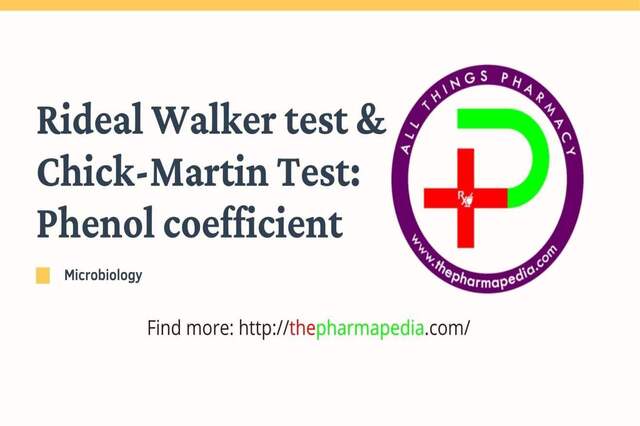Phenol compounds at a concentration of 2-5% are generally considered bactericidal, tuberculocidal, fungicidal and virucidal against lipophilic viruses. The phenol coefficient of a disinfectant is calculated by dividing the dilution of the test disinfectant by the dilution of phenol that disinfects under predetermined conditions.
Disinfectants that are more effective than phenol have a coefficient >1 & Those that are less effective have a coefficient <1
Phenol Coefficient is determined by two methods:
1. Rideal Walker test
2. Chick-Martin Test
Rideal Walker test
- Organism: Salmonella typhi suspension; Temp: 20°C;
- Subcultures are performed from both the test and phenol at intervals of 2.5, 5, 7.5 and 10 minutes.
- The plates are incubated for 48-72 hours at 37°C & observed Growth or no growth.
- R.W phenol coefficient:- That dilution of disinfectant which disinfects the suspension in a given time is divided by that dilution of phenol which disinfects the suspension in same time.
| Disinfectant | Dilution of disinfectant | time 2.5 mint | time 5 mint | time 7.5 mint | time 10 mint |
|---|---|---|---|---|---|
| Test Disinfectant | 1:100 | + | – | – | – |
| 1:200 | + | – | – | – | |
| 1:250 | + | + | – | – | |
| 1:300 | + | + | + | + | |
| 1:350 | + | + | + | + | |
| 1:400 | + | + | + | + | |
| Phenol (std.) | 1:95 | + | – | – | – |
| 1:100 | + | + | – | – | |
| 1:105 | + | + | + | – | |
| 1:110 | + | + | + | – | |
| 1:115 | + | + | + | + | |
For example Table 1 shows the results obtained when dilutions of test disinfectant was tested with Phenol (+ indicates Growth in the recovery medium, – indicates No growth in the recovery)
At 1: 100 and 1: 200 dilutions, growth was recorded at 2½ minutes, but not at 5 minutes and above for both dilutions. At dilutions of 1:250, growth was observed at 2½ minutes and 5 minutes contact times, but not at 7½ minutes and 10
minutes contact times, thus giving a Rideal-Walker Coefficient of 2.5.
Since the coefficient of a disinfectant is calculated by dividing the dilution of the test disinfectant by the dilution of phenol that disinfects under predetermined conditions.
Phenol or R W cofficient=Dilution of the test disinfectant/dilution of phenol
Phenol or R W cofficient=250/100= 2.5
Disadvantages of the Rideal-Walker test:
1- No organic matter is included ( to test efficacy in the presence of organic matter, Chick Martin test is done)
2- Microorganism Salmonella typhi may not be appropriate.
3- The time allowed for disinfection is short.
4- Used to evaluate phenolic type disinfectants only.
Chick Martin Test
- Chick Martin Test also determines the phenol coefficient of the test disinfectant like RW test. Unlike in the RW test method where the test is carried out in the water, the disinfectants are made to act in the presence of yeast suspension (or 3% dried human feces) to simulate the presence or organic matter.
- The time for subculture is fixed at 30 minutes and the organism used to test efficacy is S.typhi as well as S.aureus.
| Disinfectant | Conc. (%) | Sub- cultures 1 | Sub- cultures 2 |
|---|---|---|---|
| Test | 1 | – | – |
| 0.9 | – | – | |
| 0.81 | – | – | |
| 0.73 | + | + | |
| 0.66 | + | + | |
| Phenol | 2 | – | – |
| 1.8 | – | – | |
| 1.62 | – | – | |
| 1.46 | + | + | |
| 1.31 | + | + |
For example, The result for Chick-Martin Coefficient determination are shown in Table 2.
At 1%, 0.9% and 0.81% there was no growth observed in the recovery media while growth was observed in the recovery media at concentrations of 0.73% and 0.66%, giving a Chick-Martin Coefficient of 2.
Chick martin phenol coefficient calculated by dividing the concentration of phenol by the mean concentration of the test disinfectant at which similar presence or absence of growth was recorded.
CM Phenol Coefficient=1.62/0.81=2


Comments are closed